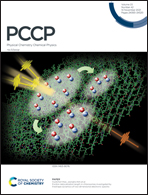Construction of frustrated Lewis pairs on carbon nitride nanosheets for catalytic hydrogenation of acetylene†
Abstract
Here, we studied Al or B atom-doped carbon nitride (g-C3N4 and C2N) as catalysts for H2 activation and acetylene hydrogenation using density functional theory calculations. The Al or B could be assembled with the surface N atoms of carbon nitride to form diverse frustrated Lewis pairs (FLPs). The results show that Al–N FLPs had lower barriers of H2 activation in comparison with B–N FLPs. The heterolytic H2 dissociation catalyzed by Al–N FLPs led to the formation of Al–H and N–H species. The Al–H species were highly active in the first hydrogenation of acetylene to C2H3*, yielding a mild barrier, while in the second hydrogenation step, the reaction between C2H3 and the H of N–H species caused a relatively high barrier. Electronic structure analysis demonstrated the electron transfer in the heterolytic H2 cleavage and explained the activity differences in various FLPs. The results suggest that Al with the surface N of carbon nitride can act as an FLP to catalyze the H2 activation and acetylene hydrogenation, thus providing a new strategy for the future development of noble metal-free hydrogenation catalysts.



 Please wait while we load your content...
Please wait while we load your content...